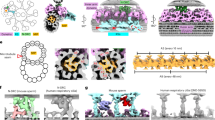Summary
The manchette or caudal tube has been examined in Stage 14 rat spermatids. The microtubules of the caudal tube have been found to be partially sheathed by smooth endoplasmic reticulum which appears to be continuous with the outer nuclear membrane of the redundant nuclear envelope. The microtubules in caudal regions of the manchette have been noted to be interconnected by links of unusual size and morphology. It is suggested that the caudal tube consists at this stage of development of two structures, membrane and microtubules and that the links between the microtubules appear to play a role in the structural order noted in the position of the tubules of the manchette. The possible significance of these links in relation to motility is discussed.
Similar content being viewed by others
References
Bedford, J. M., Nicander, L.: Ultrastructural changes in the acrosome and sperm membranes during maturation of spermatozoa in the testis and epididymis of the rabbit and monkey. J. Anat. (Lond.) 108, 527–543 (1971).
Bencosme, S.A., Stone, R. S., Latta, H., Madden, S. C.: A rapid method for localization of tissue or lesions for electron microscopy. J. biophys. biochem. Cytol. 5, 508–510 (1959).
Burgos, M. H., Fawcett, D.W.: Studies in the fine structure of the mammalian testis. I. Differentiation of the spermatids in the cat (Felix domesticus). J. biophys. biochem. Cytol. 1, 287–300 (1955).
—, Vitale-Calpe, R., Aoki, A.: Fine structure of the testis and its functional significance. In: The Testis I, p. 551–649, ed. Johnson, A. D., Gomes, W. R. and Vandemark. New York: Academic Press Inc. 1970.
Clark, A.W.: Some aspects of spermiogenesis in a lizard. Amer. J. Anat. 121, 369–400 (1967).
Clermont, Y., Perry, B.: The stages of the cycle of the seminiferous epithelium of the rat: practical definitions in PA-Schiff hematoxylin and hematoxylin-eosin stained sections. Rev. Canad. Biol. 16, 451–462 (1957).
Fawcett, D.W.: The anatomy of the mammalian spermatozoon with particular reference to the guinea pig. Z. Zellforsch. 67, 279–296 (1965).
Franklin, L. E.: Formation of the redundant nuclear envelope in monkey spermatids. Anat. Rec. 161, 149–162 (1968).
Go,V. L.W.: Personal communication (1971).
Hoage, T. R., Kessel, R. G.: An electron microscope study of the process of differentiation during spermatogenesis in the drone honey bee (Apis mellifera, L) with special reference to centriole replication and elimination. J. Ultrastruct. Res. 24, 6–32 (1968).
Horstmann, E.: Elektronenmikroskopische Untersuchungen zur Spermiohistogenese beim Menschen. Z. Zellforsch. 54, 68–89 (1961).
—: Die Elektronenmikroskopie der menschlichen Spermatozoen und des menschlichen Ductus epididymidis. Neue Ergebnisse der Andrologie, S. 8–23. Berlin-Göttingen-Heidelberg-New York: Springer 1964 (1965).
Kessel, R. G.: The association between microtubules and nuclei during spermiogenesis in the dragonfly. J. Ultrastruct. Res. 16, 293–304 (1966).
—: An electron microscope study of spermiogenesis in the grasshopper with particular reference to the development of microtubular systems during differentiation. J. Ultrastruct. Res. 18, 677–694 (1967).
Luft, J. H.: Improvements in epoxy resin embedding methods. J. biophys. biochem. Cytol. 9, 409–414 (1961).
McIntosch, J. R., Porter, K. R.: Microtubules in the spermatids of the domestic fowl. J. Cell Biol. 35, 153–173 (1967).
Porter, K. R.: Illustrations of cell fine structure. In: Ideas in Modern Biology, Int. Congr. of Zool. J. A. Moore, ed., p. 95–124. Garden City, New York: 1965.
Roth, L. E., Pihlaja, D. J., Shigenaka, Y.: Microtubules in the Heliozoan Axopodium I. The gradion hypothesis of Allosterism in structural proteins. J. Ultrastruct. Res. 30, 7–37 (1970).
Sabatini, D. D., Bensch, K., Barrnett, R. J.: Cytochemistry and electron microscopy. The preservation of cellular ultrastructure and enzyme activity by aldehyde fixation. J. Cell Biol. 17, 19–58 (1963).
Sotelo, J. R., Trujillo-Cenóz, O.: Electron microscopic study of the kinetic apparatus in animal sperm cells. Z. Zellforsch. 48, 565–601 (1958).
Susi, F. R., Clermont, Y.: Fine structural modifications of the rat chromatoid body during spermiogenesis. Amer. J. Anat. 129, 177–192 (1971).
Tilney, L. G.: The assembly of microtubules and their role in the development of cell form. Develop. Biol. 2 (Suppl) 93–102 (1968).
—, Byers, B.: Studies on the microtubules in heliozoa V. Factors controlling the organization of microtubules in the Axonemal Pattern in Echinosphaerium (Actinosphaerium nucleofilum). J. Cell. Biol. 43, 148–165 (1969).
Venable, J. H., Coggeshall, R.: A simplified lead citrate stain for use in electron microscopy. J. Cell Biol. 25, 407 (1967).
Author information
Authors and Affiliations
Additional information
Supported by a grant to E. A. MacKinnon by the Medical Research Council of Canada.
Rights and permissions
About this article
Cite this article
MacKinnon, E.A., Abraham, J.P. The manchette in Stage 14 rat spermatids: A possible structural relationship with the redundant nuclear envelope. Z. Zellforsch. 124, 1–11 (1972). https://doi.org/10.1007/BF00335450
Received:
Issue Date:
DOI: https://doi.org/10.1007/BF00335450




